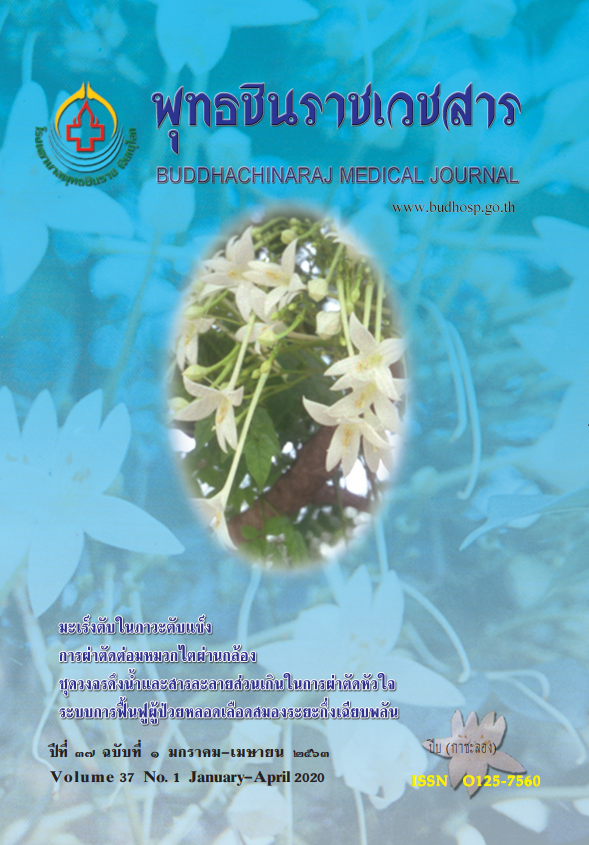การเกิดภาวะซึมเศร้าในผู้ติดเชื้อเอชไอวี/เอดส์ที่ได้รับการรักษาด้วยยาต้านไวรัส
ภาวะซึมเศร้าในผู้ติดเชื้อเอชไอวี/เอดส์
คำสำคัญ:
ผู้ติดเชื้อเอชไอวี/เอดส์, ยาต้านไวรัสเอชไอวี, แบบประเมินภาวะซึมเศร้า 9 คำถาม, ภาวะซึมเศร้าบทคัดย่อ
ปัจจุบันผู้ติดเชื้อเอชไอวี/เอดส์มีอายุขัยสูงขึ้นเนื่องจากได้รับยาต้านไวรัสทุกคนแต่ยาต้านไวรัสที่ได้รับอาจมียา rilpivirine (RPV) ซึ่งมีผลข้างเคียงคือภาวะซึมเศร้า การวิจัยแบบภาคตัดขวางนี้เพื่อประเมินภาวะซึมเศร้าใน ผู้ติดเชื้อเอชไอวี/เอดส์ที่ได้รับยาต้านไวรัสที่มี RPV กับกลุ่มที่ได้รับยาต้านไวรัสสูตรอื่น เก็บข้อมูลระหว่างวันที่ 1 มกราคม-30 เมษายน พ.ศ. 2563 โดยให้ผู้ป่วยทำแบบ ประเมิน 9Q (แบบประเมินภาวะซึมเศร้า 9 คำถาม ซึ่งมีความเที่ยงตรงในการวินิจฉัยภาวะซึมเศร้า) พบว่ามีผู้ป่วย 336 คน อายุเฉลี่ย 39.5 ปี เป็นเพศชาย 201 คน (ร้อยละ 59.8) ระยะเวลาของการติดเชื้อเฉลี่ย 7.42 ปี แบ่งเป็นกลุ่มที่ได้รับยาที่มี RPV 96 คนและ กลุ่มที่ได้รับยาสูตรอื่น 240 คน ค่าเฉลี่ยคะแนน 9Q ในกลุ่มที่ได้ยาที่มี RPV 2 คะแนนและกลุ่มที่ได้รับยาสูตรอื่น 3 คะแนน (p = 0.252) พบภาวะซึมเศร้า (คะแนน 9Q ≥ 7) ร้อยละ 20.7ปัจจัยที่เกี่ยวข้องกับภาวะซึมเศร้า ได้แก่ อายุ ≤ 35 ปี (adj OR 2.01, 95% CI 1.14-3.57, p = 0.016) และประวัติติดเชื้อวัณโรค (adj OR 2.02, 95% CI 1.01-4.05, p = 0.046) นั่นคือภาวะซึมเศร้าในผู้ติด เชื้อเอชไอวี/เอดส์พบได้บ่อย ดังนั้นผู้ป่วยทุกคนควรได้รับการประเมินภาวะซึมเศร้า โดยเฉพาะผู้ที่อายุน้อยกว่า 35 ปี หรือมีประวัติติดเชื้อวัณโรคเพื่อรักษาผู้ป่วยที่มีภาวะซึมเศร้าให้มีคุณภาพชีวิตที่ดีขึ้น
เอกสารอ้างอิง
2. Global information and education on HIV and AIDS in Thailand [online]. 2018 [cited 2020 Feb 24]. Available from: https://www.avert.org/professionals/hiv-around-world/asia-pacific/thailand
3. Gueler A, Moser A, Calmy A, Gunthard HF, Bernasconi E, Furrer H, et al. Life expectancy in HIV-positive persons in Switzerland:Matched comparison with general population.AIDS 2017;31(3):427-36.
4. Teeraananchai S, Chaivooth S, KerrS J, Bhakeecheep S, Avihingsanon A, Teeraratkul A, et al. Life expectancy after initiation of combination antiretroviral therapy in Thailand. AntivirTher 2017;22(5):393-402.
5. Department of Disease Control of Thailand, Ministry of Public Health. Thailand National Guidelines on HIV/AIDS Treatment and Prevention 2017. Bangkok: Department of Disease Control of Thailand, Ministry of Public Health; 2014.
6. Department of Health and Human Services. Guidelines for the Use of Antiretroviral Agents in HIV-1-Infected Adults and Adolescents [online]. 2018 [cited 2019 Mar 2]. Available from: http://www. aidsinfo.nih.gov/ContentFiles/AdultandAdolescent
GL. pdf
7. Cohen CJ, Molina JM, Cahn P, Clotet B, Fourie J, Grinsztejn B, et al. Efficacy and safety of rilpivirine (TMC278) versus efavirenz at 48 weeks in treatment-naive HIV-1-infected patients: Pooled results from the Phase 3 Double-Blind Randomized ECHO and THRIVE Trials. J Acquir Immune Defic Syndr 2012;60(1):33-42.
8. Kongsuk T, Kittirattanapaiboon P, Kenbubpha K, Sukawaha S, Leejongpermpoon J. The prevalence of major depressive disorders in Thailand: Results from the epidemiology of mental disorders national survey 2008. Proceedings of WPA Section on Epidemiology and Public Health-2010 Meeting Prediction in Psychiatric Epidemiology from Childhood and Adolescence to Adulthood; 2010 Jul 11-14; Lisbon Portugal.
9. Department of Mental Health, Ministry of Public Health. Report on access to services for patients with major depressive disorder [online]. 2019 [cited 2020 Feb 24]. Available from: http://www.thaidepression.com/www/report/main_report/pdf/ahb-11-19_mix_HDC.pdf
10. Nanni MG, Caruso R, Mitchell AJ, Meggiolaro E, Grassi L. Depression in HIV infected patients: A review. Curr Psychiatry Rep 2015;17(1):530-4.
11. Katon W. The impact of depression on workplace functioning and disability costs. Am J Manag Care 2009;15(Suppl 11):s322-7.
12. Uthman OA, Magidson JF, Safren SA, Nachega JB. Depression and adherence to antiretroviral therapy in low-, middle-and high-income countries: A systematic review and meta-analysis. Curr HIV/AIDS Rep 2014;11(3):291-307.
13. Oluboka OJ, Katzman MA, Habert J, Mclntosh D, MacQueen GM, Milev RV, et al. Functional recovery in major depressive disorder: Providing early optimal treatment for the individual patient. Int J Neuropsychopharmacol 2018;21(2):128-44.
14. Bhatia MS, Munjal S.Prevalence of depression in people living with HIV/AIDS undergoing ART and factors associated with it. J ClinDiagn Res 2014;8(10):WC01-4.
15. Jiranukool J, Kotputorn N, Sirisanokaeo T. Prevalence of psychiatric disorders, gender differences and a comparison between depressive or anxiety disorders and adjustment disorders among Mahasarakham University Students at Psychiatric clinic. J Psychiatr Assoc Thailand 2018;63(3):271-84.
16. Charoensak S, Sittironnarit G, Satra T, Muangpaisan W, Srinontprasert. Prevalence of psychiatric disorders in elderly patients, quality of life of patients and caregivers and their correlated factors. J Psychiatr Assoc Thailand 2018;63(1):89-98.
17. Datta D. Prevalence & determinants of depression in type 2 diabetes patients:Problem in generalization. Indian J Med Res 2011;133(5):555-6.
18. Dasa TT, Roba AA, Weldegebreal F, Mesfin F, Asfaw A, Mitiku H, et al. Prevalence and associated factors of depression among tuberculosis patients in Eastern Ethiopia. BMC Psychiatry 2019;19(1):82-6.






